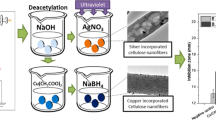Abstract
A copper-based metal–organic frameworks/cellulose fibers (HKUST-1/CF) composite was prepared by in situ and green method. Scanning electron microscopy with energy dispersive X-ray spectroscopy, Fourier transform infrared spectroscopy and X-ray diffraction analyses revealed the functionalization of cellulose fibers (CFs) was successfully achieved by in situ deposition of HKUST-1 via a DMF-free green process. The synthetized HKUST-1/CF composite exhibited excellent antibacterial activity against Escherichia coli and Staphylococcus aureus. The composite was more effective against Gram-positive S. aureus than Gram-negative E. coli. The optimization of process variables indicated that the novel composite could be prepared at room temperature for a short time.






Similar content being viewed by others
References
Achmann S, Hagen G, Kita J, Malkowsky IM, Kiener C, Moos R (2009) Metal–organic frameworks for sensing applications in the gas phase. Sensors 9(3):1574–1589
Barea E, Montoro C, Navarro JA (2014) Toxic gas removal–metal–organic frameworks for the capture and degradation of toxic gases and vapours. Chem Soc Rev 43(16):5419–5430
Cai A, Sun Y, Chang Y, Guo A, Du L (2014) Biopolymer-assisted in situ route toward Cu hollow spheres as antibacterial materials. Mater Lett 134:214–217
Chui SS-Y, Lo SM-F, Charmant JPH, Orpen AG, Williams ID (1999) A chemically functionalizable nanoporous material [Cu3(TMA)2(H2O)3]n. Science 283(5405):1148–1150
da Silva Pinto M, Sierra-Avila CA, Hinestroza JP (2012) In situ synthesis of a Cu-BTC metal–organic framework (MOF 199) onto cellulosic fibrous substrates: cotton. Cellulose 19(5):1771–1779
Davydovskaya P, Ranft A, Lotsch BV, Pohle R (2014) Analyte detection with Cu-BTC metal–organic framework thin films by means of mass-sensitive and work-function-based readout. Anal Chem 86(14):6948–6958
DeCoste JB, Peterson GW (2014) Metal–organic frameworks for air purification of toxic chemicals. Chem Rev 114(11):5695–5727
Hasan Z, Jhung SH (2015) Removal of hazardous organics from water using metal–organic frameworks (MOFs): plausible mechanisms for selective adsorptions. J Hazard Mater 283:329–339
Khan NA, Jhung SH (2015) Synthesis of metal–organic frameworks (MOFs) with microwave or ultrasound: rapid reaction, phase-selectivity, and size reduction. Coord Chem Rev 285:11–23
Kim JD, Yun H, Kim GC, Lee CW, Choi HC (2013) Antibacterial activity and reusability of CNT-Ag and GO-Ag nanocomposites. Appl Surf Sci 283:227–233
Kim D, Lim HK, Ro H, Kim H, Lee H (2015) Unexpected carbon dioxide inclusion in water-saturated pores of metal–organic frameworks with potential for highly selective capture of CO2. Chemistry 21(3):1125–1129
Koga H, Kitaoka T, Wariishi H (2009) In situ synthesis of silver nanoparticles on zinc oxide whiskers incorporated in a paper matrix for antibacterial applications. J Mater Chem 19(15):2135–2140
Küsgens P, Siegle S, Kaskel S (2009) Crystal growth of the metal–organic framework Cu3(BTC)2 on the surface of pulp fibers. Adv Eng Mater 11(1–2):93–95
Lange LE, Obendorf SK (2015) Functionalization of cotton fiber by partial etherification and self-assembly of polyoxometalate encapsulated in Cu3(BTC)2 metal–organic framework. ACS Appl Mater Interfaces 7(7):3974–3980
Lei J, Qian R, Ling P, Cui L, Ju H (2014) Design and sensing applications of metal–organic framework composites. Trac Trend Anal Chem 58:71–78
Li B, Li Y, Zhao Y, Sun L (2013) Shape-controlled synthesis of Cu2O nano/microcrystals and their antibacterial activity. J Phys Chem Solids 74(12):1842–1847
Li J, Wang G, Zhu H, Zhang M, Zheng X, Di Z, Liu X, Wang X (2014) Antibacterial activity of large-area monolayer graphene film manipulated by charge transfer. Sci Rep 4:4359. doi:10.1038/srep04359
Lin S, Song Z, Che G, Ren A, Li P, Liu C, Zhang J (2014) Adsorption behavior of metal–organic frameworks for methylene blue from aqueous solution. Microporous Mesoporous Mater 193:27–34
Ling Y, Luo Y, Luo J, Wang X, Sun R (2013) Novel antibacterial paper based on quaternized carboxymethyl chitosan/organic montmorillonite/Ag NP nanocomposites. Ind Crops Prod 51:470–479
Lu X, Ye J, Zhang D, **e R, Bogale RF, Sun Y, Zhao L, Zhao Q, Ning G (2014) Silver carboxylate metal–organic frameworks with highly antibacterial activity and biocompatibility. J Inorg Biochem 138:114–121
Majano G, Perez-Ramirez J (2013) Scalable room-temperature conversion of copper(II) hydroxide into HKUST-1 (Cu3(btc)2). Adv Mater 25(7):1052–1057
Park SY, Ryu S-Y, Kwak S-Y (2011) Antibacterial metal-fiber hybrid with covalent assembly of silver and palladium nanoparticles on cellulose fibers. In: Proceedings of international conference on biology, environment and chemistry (ICBEC 2010), IACSIT Press, Singapore, pp 183–186
Ramli R, Khan MMR, Yunus RM, Ong HR, Halim RM, Aziz AA, Ibrahim Z, Zainal NH (2014) In-situ impregnation of copper nanoparticles on palm empty fruit bunch powder. Adv Nanopart 3:65–71
Rodriguez HS, Hinestroza JP, Ochoa-Puentes C, Sierra CA, Soto CY (2014) Antibacterial activity against escherichia coli of Cu-BTC (MOF-199) metal–organic framework immobilized onto cellulosic fibers. J Appl Polym Sci 131(19):40815. doi:10.1002/app.40815
Rowsell JLC, Yaghi OM (2004) Metal–organic frameworks: a new class of porous materials. Microporous Mesoporous Mater 73(1–2):3–14
Shekhah O, Liu J, Fischer RA, Wöll Ch Ch (2011) MOF thin films: existing and future applications. Chem Soc Rev 40:1081–1106
Song G, Wang Z, Wang L, Li G, Huang M, Yin F (2014) Preparation of MOF(Fe) and its catalytic activity for oxygen reduction reaction in an alkaline electrolyte. Chin J Catal 35(2):185–195
Sun B, Kayal S, Chakraborty A (2014) Study of HKUST (copper benzene-1,3,5-tricarboxylate, Cu-BTC MOF)-1 metal organic frameworks for CH4 adsorption: an experimental investigation with GCMC (grand canonical Monte-carlo) simulation. Energy 76:419–427
Vicent-Luna JM, Gutiérrez-Sevillano JJ, Anta JA, Calero S (2013) Effect of room-temperature ionic liquids on CO2 separation by a Cu-BTC metal–organic framework. J Phys Chem C 117(40):20762–20768
Wang Z, Wang J, Li M, Sun K, Liu CJ (2014) Three-dimensional printed acrylonitrile butadiene styrene framework coated with Cu-BTC metal–organic frameworks for the removal of methylene blue. Sci Rep 4:5939. doi:10.1038/srep05939
Author information
Authors and Affiliations
Corresponding author
Rights and permissions
About this article
Cite this article
Wang, C., Qian, X. & An, X. In situ green preparation and antibacterial activity of copper-based metal–organic frameworks/cellulose fibers (HKUST-1/CF) composite. Cellulose 22, 3789–3797 (2015). https://doi.org/10.1007/s10570-015-0754-4
Received:
Accepted:
Published:
Issue Date:
DOI: https://doi.org/10.1007/s10570-015-0754-4




